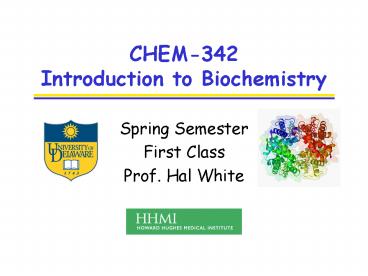CHEM-342 Introduction to Biochemistry - PowerPoint PPT Presentation
Title:
CHEM-342 Introduction to Biochemistry
Description:
CHEM-342 Introduction to Biochemistry Spring Semester First Class Prof. Hal White Topics for Today Overview of the Course What is Problem-Based Learning (PBL ... – PowerPoint PPT presentation
Number of Views:132
Avg rating:3.0/5.0
Title: CHEM-342 Introduction to Biochemistry
1
CHEM-342Introduction to Biochemistry
- Spring Semester
- First Class
- Prof. Hal White
2
Topics for Today
- Overview of the Course
- What is Problem-Based Learning (PBL)
- Introductions
- First Assignment (on-line by today!)
- Second Assignment
3
What was the On-Line Questionnaire About?
- Tell me something about you
- Tell me something about the class
- Get you thinking about big issues and this course
4
Administrative Details
- Check out the syllabus and schedule at
www.udel.edu/chem/white/CHEM342.html - Purchase a course reader at the Bookstore
- Buy a 3-ring binder for your reader
- Groups will be formed on Wednesday
5
(No Transcript)
6
once you have learned to ask questions
relevant and appropriate and substantial questions
you have learned how to learn and no one can
keep you from learning whatever you want or need
to know.
Neil Postman Charles Weingartner in Teaching
as a Subversive Activity, 1969
7
Teaching as a Subversive Activity
- A major goal of higher education is to enable
students to think independently. - Independent thinkers seek understanding.
- Independent thinkers challenge superficial
answers. - Independent thinkers develop strong convictions.
- Independent thinkers question authority.
- Independent thinkers become leaders.
- If you dont change as a result of taking this
course, we are wasting our time.
8
Characteristics Needed For Success
1. Communication Skills - both verbal and
written. 2. Ability to define problems, gather
and evaluate information related to the problem,
and develop solutions. 3. Ability to work with
others, especially in team settings. 4. Ability
to address specific problems in complex,
real-world settings. From 1994 Wingspread
Conference on Quality Assurance in Undergraduate
Education
9
Characteristics Needed For Success
Oral
Written
Visual
Communication Skills
10
Characteristics Needed For Success
Education and Training
Problem- Solving Ability
Acquired Skills
Accumulated Knowledge
11
Introduction to BiochemistryInstructional Goals
For Students
- Become intellectually independent learners
- Recognize and confront areas of personal
ignorance - Review and apply chemical, biological, physical,
and mathematical principles in a biochemical
context - Improve problem-solving skills
- Create, understand, and value abstract
biochemical models - See biochemistry in relevant historical and
societal contexts
12
Introduction to BiochemistryInstructional Goals
For Students, Cont.
- Discover and use the resources of the library and
the Internet - Gain confidence in reading and understanding
scientific articles - Experience the powers (and pitfalls) of
collaborative work - Appreciate importance of clear oral and written
communication - Learn to organize logical arguments based on
evidence
13
Introduction to BiochemistrySpecial Goal and
Challenge
For this class, as a group, to become
sufficiently skilled learners to score above the
class average in CHEM-641 next fall. In
order for this to happen, you will need to work
individually and together so that everyone
learns. Everyone here has unique and special
abilities, background, and personality to
contribute to the effort.
14
Introduction to BiochemistryRelation to Other
Science Courses
Biology
Chemistry
Provides the methods and molecular perspective
Provides the relevance
Biochemistry
Provides the means to evaluate and predict
Provides physical models
Physics
Mathematics
15
Teaching Learning?
16
Problem-Based Learning The Process
- Learning initiated with problem.
- Students organize ideas and previous knowledge.
- Students pose questions, defining what they know
and dont know. - Assign responsibility for questions, discuss
resources. - Reconvene, explore newly learned information,
refine questions.
17
Problem-Based Learning The Process
Resolution of Problem (How did we do?)
Presentation of Problem
Next stage of the problem
Organize ideas and prior knowledge (What do we
know?)
Integrate new Information Refine questions
Pose questions (What do we need to know?)
Reconvene, report on research
Assign responsibility for questions discuss
resources
Research questions summarize analyze findings
18
PBL Course Content
- Contrary to popular belief, this course is NOT
about Hemoglobin and Sickle Cell Anemia, though
you will learn a lot about both. - Hemoglobin is a central molecule in biochemistry
and thus serves as a unifying theme to introduce
many concepts and connections. - Any one of a number of other themes could serve
the same purpose, e.g. Insulin and Diabetes or
Vitamin C and the Common Cold.
19
For Group Discussion (10 Minutes)
- Have you had a course that used Problem-Based
Learning or groups? - What did you like or dislike about it? Make a
list. - What can be done to lessen the perceived
drawbacks?
20
Who are you?
- Who do you think you are?
- I dont want to know your age, religion, what
part of the country you come from. They dont
mean a thing. What I really want to know is what
you love. Because if I know what you love, I know
what is important to you. - (From ad on WLFN years ago)
- Introduce yourself to the class and say something
about yourself. e.g. What do you love to do?































